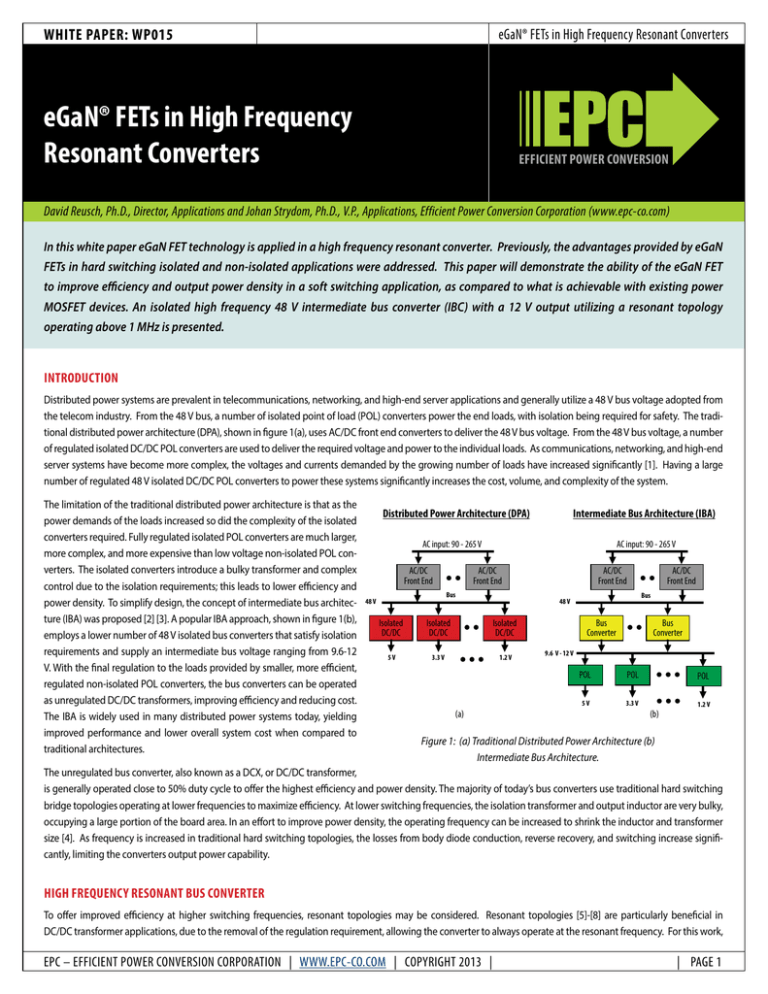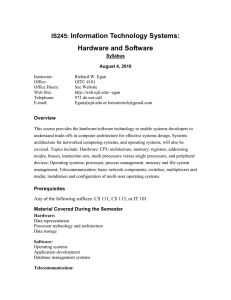eGaN® FETs in High Frequency Resonant Converters
advertisement

WHITE PAPER: WP015 eGaN® FETs in High Frequency Resonant Converters eGaN® FETs in High Frequency Resonant Converters EFFICIENT POWER CONVERSION David Reusch, Ph.D., Director, Applications and Johan Strydom, Ph.D., V.P., Applications, Efficient Power Conversion Corporation (www.epc-co.com) In this white paper eGaN FET technology is applied in a high frequency resonant converter. Previously, the advantages provided by eGaN FETs in hard switching isolated and non-isolated applications were addressed. This paper will demonstrate the ability of the eGaN FET to improve efficiency and output power density in a soft switching application, as compared to what is achievable with existing power MOSFET devices. An isolated high frequency 48 V intermediate bus converter (IBC) with a 12 V output utilizing a resonant topology operating above 1 MHz is presented. Introduction Distributed power systems are prevalent in telecommunications, networking, and high-end server applications and generally utilize a 48 V bus voltage adopted from the telecom industry. From the 48 V bus, a number of isolated point of load (POL) converters power the end loads, with isolation being required for safety. The traditional distributed power architecture (DPA), shown in figure 1(a), uses AC/DC front end converters to deliver the 48 V bus voltage. From the 48 V bus voltage, a number of regulated isolated DC/DC POL converters are used to deliver the required voltage and power to the individual loads. As communications, networking, and high-end server systems have become more complex, the voltages and currents demanded by the growing number of loads have increased significantly [1]. Having a large number of regulated 48 V isolated DC/DC POL converters to power these systems significantly increases the cost, volume, and complexity of the system. The limitation of the traditional distributed power architecture is that as the power demands of the loads increased so did the complexity of the isolated converters required. Fully regulated isolated POL converters are much larger, more complex, and more expensive than low voltage non-isolated POL converters. The isolated converters introduce a bulky transformer and complex control due to the isolation requirements; this leads to lower efficiency and power density. To simplify design, the concept of intermediate bus architecture (IBA) was proposed [2] [3]. A popular IBA approach, shown in figure 1(b), employs a lower number of 48 V isolated bus converters that satisfy isolation requirements and supply an intermediate bus voltage ranging from 9.6-12 V. With the final regulation to the loads provided by smaller, more efficient, regulated non-isolated POL converters, the bus converters can be operated as unregulated DC/DC transformers, improving efficiency and reducing cost. The IBA is widely used in many distributed power systems today, yielding improved performance and lower overall system cost when compared to traditional architectures. Distributed Power Architecture (DPA) Intermediate Bus Architecture (IBA) AC input: 90 - 265 V AC/DC Front End AC input: 90 - 265 V AC/DC Front End Bus 48 V AC/DC Front End AC/DC Front End Bus 48 V Isolated DC/DC Isolated DC/DC Isolated DC/DC 5V 3.3 V 1.2 V (a) Bus Converter Bus Converter 9.6 V - 12 V POL POL 5V 3.3 V POL (b) 1.2 V Figure 1: (a)Figure Traditional DistributedDistributed Power Architecture (b) Intermediate Bus Architecture. 1: (a) Traditional Power Architecture (b) Intermediate Bus Architecture. The unregulated bus converter, also known as a DCX, or DC/DC transformer, is generally operated close to 50% duty cycle to offer the highest efficiency and power density. The majority of today’s bus converters use traditional hard switching bridge topologies operating at lower frequencies to maximize efficiency. At lower switching frequencies, the isolation transformer and output inductor are very bulky, occupying a large portion of the board area. In an effort to improve power density, the operating frequency can be increased to shrink the inductor and transformer size [4]. As frequency is increased in traditional hard switching topologies, the losses from body diode conduction, reverse recovery, and switching increase significantly, limiting the converters output power capability. High Frequency Resonant Bus Converter To offer improved efficiency at higher switching frequencies, resonant topologies may be considered. Resonant topologies [5]-[8] are particularly beneficial in DC/DC transformer applications, due to the removal of the regulation requirement, allowing the converter to always operate at the resonant frequency. For this work, EPC – EFFICIENT POWER CONVERSION CORPORATION | WWW.EPC-CO.COM | COPYRIGHT 2013 | | PAGE 1 WHITE PAPER: WP015 eGaN® FETs in High Frequency Resonant Converters the benefits of the eGaN FET applied in a high frequency intermediate bus converter (IBC) will be considered. The topology, shown in figure 2, employs a resonant technique that utilizes the transformer’s magnetizing inductance (LM) and resonance of the leakage inductance (LK), with a small output capacitance (CO), to achieve zero voltage switching (ZVS), limit turn off current, and eliminate body diode conduction [5]. Vgs (Q2,4) Vgs (S2) 0 Vgs (Q1,3) Vgs (S1) 0 LK1 ILK1 4:1 Q1 48 V Q4 ILk1 0 S1 C0 ILk2 + + VP – ILM 0 12 V – Q2 Q3 ILK2 Vds (Q1) S2 Vin 0 Vds (S1) 0 LK2 2 Vo t0 t 1 t 2 t3 (b) Operating Waveforms (a) Schematic Figure 2: High Frequency Bus Converter [5]. Experimental Setup Figure 2: High Frequency Bus Converter [5]. To obtain a direct comparison in performance between eGaN FETs and Si MOSFETs in the high frequency resonant bus converter application, devices with similar on-resistance were selected, the same circuit topology was used, and a similar layout was maintained for the eGaN FET and MOSFET designs. Direct comparisons of the key parameters for the eGaN FETs and Si MOSFETs are shown in tables I and II. The Figures of Merit (FOMs) used in this work are QG x RDS(ON) and QOSS x RDS(ON). These particular FOMs were selected due to the soft switching topology that reduces the switching related losses, therefore resulting in the FET gate drive and conduction being the major loss contributors. The device output charge has a direct impact on the energy required to achieve ZVS. A reduction in energy required to achieve ZVS can result in reduced dead time, providing a larger power delivery period (t0-t1 in figure 2(b)) and lower RMS currents in a high frequency resonant converter. The eGaN FETs show significant improvements when compared to Si MOSFETs, with the gate drive FOM improving by a factor of approximately 4 and 3 for the 100 V and 40 V devices respectively, while the output charge FOM is improved around a factor of 1.6 and 2 for the primary and secondary devices respectively. The eGaN FET also provides performance improvements in the form of reduced miller charge that reduces the turn off switching losses incurred in the primary devices. As a further advantage, the LGA packaging of the eGaN FET has low parasitic package inductance compared to the traditional Si MOSFET package (SuperSO8). When putting all these benefits together, multi-MHz switching frequencies can be obtained through the use of advanced topologies combined with low loss eGaN FETs. Device Comparison Parameter EPC2001 BSC057N08 Voltage Rating (VDSS) 100 V 80 V RDS (ON) 5.6 mΩ @ 5 V 5.2 mΩ @ 8 V* QG under ZVS 5.8 nC @ 5 V 25.9 nC @ 8 V* QGD @ VIN 2.2 nC 8.1 nC* QOSS @ VIN 35 nC 62 nC* FOM = QG x RDS (ON) 32.5 pC·Ω 134.7 pC·Ω FOM = QOSS x RDS (ON) 196 pC·Ω 322.4 pC·Ω Note 1: *Calculated from manufacturers datasheet curves Table I: Device comparison between eGaN FETs and Si MOSFETs for primary devices for VIN = 48 V, VOUT = 12 V. Device Comparison Parameter EPC2015 BSC027N04 Voltage Rating (VDSS) 40 V 40 V RDS(ON) 3.2 mΩ @ 5 V 2.9 mΩ @5 V* QG under ZVS 8.3 nC @ 5 V 27.5 nC @5 V* QGD @ 20 V 2.2 nC 6.5 nC QOSS @ 20 V 18.5 nC 40 nC FOM = QG x RDS (ON) 26.6 pC·Ω 79.8 pC·Ω FOM = QOSS x RDS (ON) 59.2 pC·Ω 116 pC·Ω Note 1: *Calculated from manufacturers datasheet curves Table II: Device comparison between eGaN FETs and Si MOSFETs for secondary devices for VIN = 48 V, VOUT = 12 V. EPC – EFFICIENT POWER CONVERSION CORPORATION | WWW.EPC-CO.COM | COPYRIGHT 2013 | | PAGE 2 WHITE PAPER: WP015 eGaN® FETs in High Frequency Resonant Converters Experimental Results To compare the performance of eGaN FETs and Si MOSFETs Resonant in high frequency resonant converters, two experimental Capacitor prototypes, shown in figure 3, were designed and tested Secondary Devices based on the schematic in figure 2(a). To accurately compare only device performance, these prototypes both had the Transformer same 3F45 Mn-Zn transformer core and identical windings Primary Devices designed from [4]. The placement of the primary side input capacitors and secondary resonant capacitors were similar Input Capacitor for both designs to ensure similar parasitic inductances for the primary and secondary loops, with the only differences being those introduced by the different packages of the Si MOSFETs and eGaN FETs. By using eGaN FETs with lower (b) eGaN FETs (a) Si MOSFET specific RDS(ON) and improved packaging, the active footprint area shrank significantly, reducing the power stage size by Figure 3: Experimental bus converter prototypes for VIN=48 V, VOUT=12 V. 30% compared to the Si MOSFET benchmark design. The Figure 3: Experimental bus converter prototypes for VIN=48 V, VOUT=12 V. eGaN FET–based design used LM5113 drivers from Texas Instruments for the primary and secondary devices, driving the devices at 5 V. The Si MOSFET–based design used drivers comparable in performance to the LM5113 with an 8 V drive for the primary and a 5 V drive for the secondary to provide improved high frequency Si MOSFET performance by reducing dominant gate losses for a small penalty in the on state resistance. For both designs, the gate drives were placed on the backside of the board. The generation of these driver chip voltages from the nominal 48 V input are not included in this work, but the gate drive losses incurred in the switches are considered. The experimental switching waveforms for the designs at 1.2 MHz are shown in figures 4 and 5. Both designs have the same magnetizing inductance, built into the transformer via an air gap, to achieve zero voltage switching during device off state (t1-t2 in figure 2(b)). Due to almost a factor of 2 decrease in output charge (QOSS) provided by the primary and secondary eGaN FETs, the ZVS transition is achieved in a proportionally shorter period, increasing the effective duty cycle and improving the overall converter performance. For the Si MOSFET design, the dead time required for ZVS was measured to be 87 ns and the effective duty cycle for each device was limited to 34%. With the faster switching eGaN FETs the dead time was reduced to 42 ns, resulting in a 42% duty cycle for each device, allowing for an increased power delivery period. From the switching waveforms it can also be seen that the gate drive speed for the eGaN FET is significantly faster than the Si MOSFET counterpart even when driven with a lower gate drive voltage, providing both faster switching speed and reduced gate losses. DeGaN = 0.42 eGaN V DS T ZVS = 42 nS MOSFET VDS TZVS = 87 nS DMOSFET = 0.34 MOSFET VGS MOSFET VGS eGaN VDS MOSFET VDS eGaN VGS Figure 4: ZVS switching transitions for primary side eGaN FET and Si MOSFET designs at FS = 1.2 MHz, VIN = 48 V, and IOUT = 26 A. eGaN VGS Figure 5: Switching waveforms showing effective duty cycle for primary side eGaN FET and Si MOSFET designs at FS = 1.2 MHz, VIN = 48 V, and IOUT = 26 A. EPC – EFFICIENT POWER CONVERSION CORPORATION | WWW.EPC-CO.COM | COPYRIGHT 2013 | | PAGE 3 WHITE PAPER: WP015 The loss breakdown for the 1.2 MHz designs at output currents of 2.5 A and 20 A is shown in figure 7 and leads to the conclusion that the eGaN FET reduces gate drive losses and improves efficiency for all load conditions. At high currents, the conduction loss dominates total power loss, but the eGaN FET converter’s shorter ZVS dead time provides reduced conduction losses due to lower RMS currents, which are inversely proportional to the effective duty cycle. Another impact of the reduced ZVS time on the eGaN FET converter is an increase in transformer core loss, which is a result of the higher transformer flux density generated from an increase in the duration of the power transferring period. The increase in transformer core loss is much smaller than the reduction in conduction losses at high current, leading to larger power savings at high currents for the eGaN design. 98 10 W 12 W 1.2 MHz eGaN 97 14 W Efficiency (%) 96 95 1.2 MHz MOSFET 94 93 92 91 90 0 5 10 15 20 25 Output Current (IOUT) 30 35 40 35 40 24 22 20 Power Loss (W) The comparison in efficiency and power loss between the two designs operating at 1.2 MHz is shown in figure 6. The eGaN FET based converter offers a one-percentage point improvement in peak efficiency over its Si MOSFET counterpart, resulting in about a 25% decrease in power loss. Since brick designs are thermally limited by a given full load loss based on the size of the converter, the reduction in power loss translates directly into higher output power handling capability. The eGaN FET converter can increase the output power capability by up to 65 W while maintaining the same total converter loss when compared to the benchmark Si MOSFET design. Assuming around a 12 W maximum power loss for both designs, the output power of the eGaN FET based converter increases from 270 W to 325 W. eGaN® FETs in High Frequency Resonant Converters 1.2 MHz MOSFET 18 16 14 12 10 From the results at 1.2 MHz it can be seen that the Si MOSFET converter is approaching its frequency limit – i.e. the ZVS transition time is becoming a significant portion of the overall period, while the eGaN FET has the capability to further increase switching frequency. To compare the frequency improvements possible with eGaN FETs over Si MOSFETs the converter frequency was reduced to 800 kHz for the Si MOSFET design and the eGaN design was increased to 1.6 MHz. For both of these designs, the core structure remained the same and was not optimized for the different operating frequencies. 8 1.2 MHz eGaN 6 4 2 0 5 10 15 20 25 Output Current (IOUT) 30 Figure 6: Experimental comparison between eGaN FET and Si MOSFET based VIN = 48 V, VOUT = 12 V, FS = 1.2 MHz resonant bus converters. 12 Power Loss (W) 10 8 Gate Drive Transfomrer Core Conduction + Turn Off 6 4 2 0 eGaN FET I OUT = 2.5A Si FET I OUT = 2.5A eGaN FET I OUT = 20A Si FET I OUT = 20A Figure 7: Loss breakdown of eGaN FET and Si MOSFET based VIN = 48 V, VOUT = 12 V, FS = 1.2 MHz resonant bus converters. EPC – EFFICIENT POWER CONVERSION CORPORATION | WWW.EPC-CO.COM | COPYRIGHT 2013 | | PAGE 4 WHITE PAPER: WP015 eGaN® FETs in High Frequency Resonant Converters The efficiency and loss comparisons between the designs are shown in figure 8, with the eGaN FET design offering a 0.9% peak efficiency improvement and lower power loss up to an output current of 29 A. The sharp drop off in efficiency at currents above 20 A for the eGaN FET based converter is a result of the increased AC transformer winding losses and reduced effective duty cycle incurred at the high frequency. Conversely, the flattening out of the efficiency for the 800 kHz Si MOSFET design was a result of the reduced AC transformer winding losses and higher effective duty cycle at the lower frequency. 98 24 1.6 MHz eGaN 97 10 W 12 W 22 14 W 20 Power Loss (W) Efficiency (%) 96 95 0.8 MHz MOSFET 94 93 1.2 MHz MOSFET 18 16 14 12 10 8 92 1.2 MHz eGaN 6 91 4 2 90 0 5 10 15 20 25 Output Current (IOUT) 30 35 40 0 5 10 15 20 25 Output Current (IOUT) 30 35 40 Figure 8: Experimental comparison between FS = 1.6 MHz eGaN FET and FS = 800 kHz Si MOSFET based VIN = 48 V, VOUT = 12 V resonant bus converter. Summary It has been previously shown that eGaN FETs have a distinct advantage over silicon MOSFETS in two key parameters – QGD and QRR – both of which are critical in hard switched applications, but have little impact in soft switching converters. In this work it was demonstrated that eGaN FETs can also provide significant improvements in the performance of soft switching/resonant converters when compared to Si MOSFETs. In high frequency applications, the reduction in: 1) Output capacitance can decrease circulating energy and commutation time required to achieve ZVS, thus increasing the effective power delivery intervals and improving overall efficiency. 2) Gate capacitance provided by the eGaN FETs results in faster switching speeds, at reduced driving voltages, which provide reduced gate drive losses. Putting eGaN FETs to work in high frequency applications can help push the frequency without sacrificing converter performance. References: [1] M. M. Jovanovic, “Power Conversion Technologies For Computer, Networking, And Telecom Power Systems - Past, Present And Future,” International Power Conversion & Drive Conference (IPCDC) St. Petersburg, Russia, June 8-9, 2011. [2] Martin F. Schlecht, “High Efficiency Power Converter,” United State Patent No. 7,269,034. [3] White, R. V., “Emerging On-Board Power Architectures,” APEC ‘03, Eighteenth Annual IEEE, Volume 2, 9-13 Feb. 2003, pp. 799-804. [4] Reusch, D.; Lee, F.C.; “High Frequency Bus Converter With Low Loss Integrated Matrix Transformer,” Applied Power Electronics Conference and Exposition (APEC), 2012 Twenty-Seventh Annual IEEE, pp.1392-1397, 5-9 Feb. 2012. [5] Y. Ren, M. Xu, J. Sun, and F. C. Lee, “A Family Of High Power Density Unregulated Bus Converters,” IEEE Transactions, Power Electron, Vol. 20, no. 5, pp. 1045–1054, Sep. 2005. [6] Y. Ren, “High Frequency, High Efficiency Two-Stage Approach for Future Microprocessors,” Ph.D. Dissertation, Virginia Tech, Blacksburg, Virginia, April 2005. [7] Y. Ren, F.C. Lee, and M. Xu, “Power Converters Having Capacitor Resonant With Transformer Leakage Inductance,” U.S. Patent 7,196,914, March 27 2007. [8] Patrizio Vinciarelli, “Point of load sine amplitude converters and methods,” U.S. Patent 7,145,786, Dec. 5 2006. EPC – EFFICIENT POWER CONVERSION CORPORATION | WWW.EPC-CO.COM | COPYRIGHT 2013 | | PAGE 5


